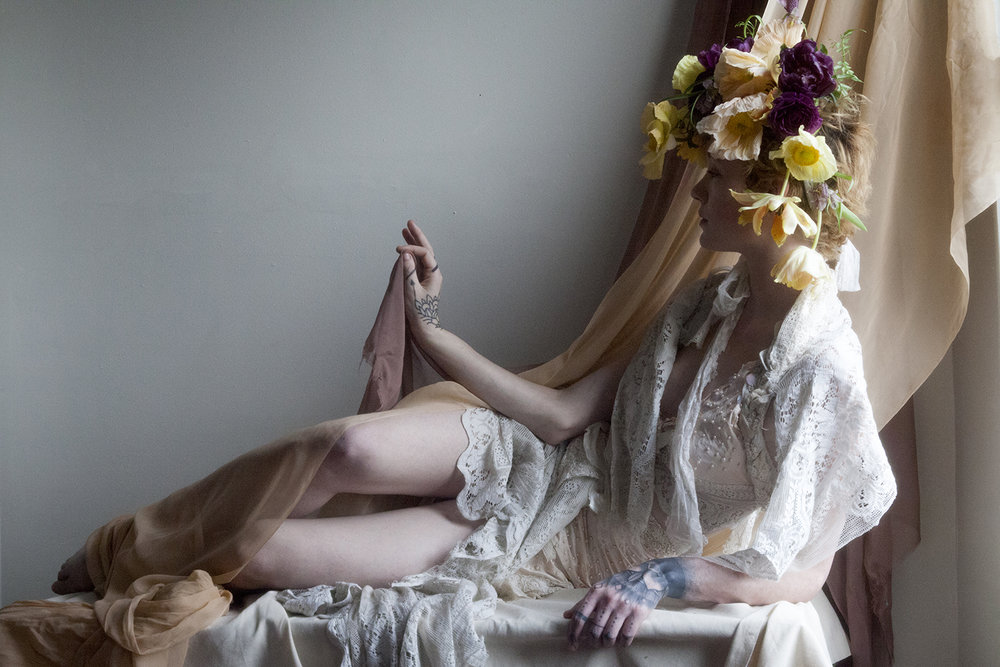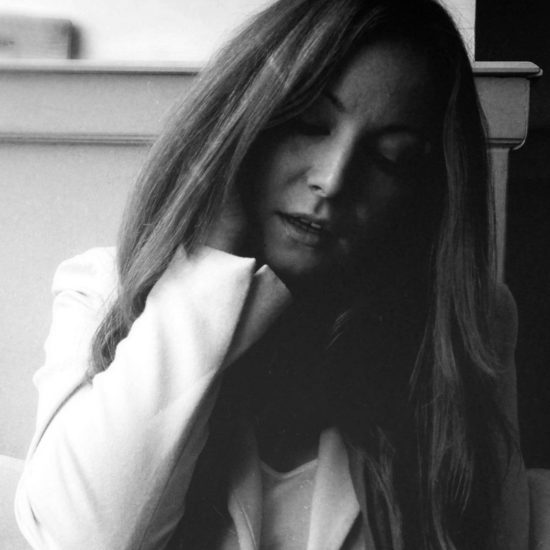In our increasingly aesthetic and image-saturated world, we are constantly surrounded by people and products touting themselves as art or cloaking themselves in the air of “culture”. While art is always a highly personal and malleable thing to define, this interesting time we find ourselves in — where the internet is reshaping old paradigms and simultaneously granting larger platforms to some while also making it harder than ever to get noticed through all the noise and sameness — its definition is more interesting than ever to explore. And to explore it, I knew no better person to talk to than Ashley Garner. Ashley is a talented conceptual photographer and video artist who also has a powerful, poetic way with words. I’ve been following her work for years now and am always impressed by the level of quality, passion, and professionalism she brings to anything that she does.
In five questions below, we dig into what it means to earn a living in the art world today. Ashley shares her views on what it means to be an artist, thinks about how people can make ends meet financially with their art and investigates how the art of the culture industry differs from “true art”.
Dive in for tons of thought-provoking tidbits and Ashley’s insightful views on a world she works, lives and breathes within.
~

1. When did you first consider yourself an artist?
I didn’t consider myself an artist until after shooting my first conceptual photographic and video series, Mermaid Food. Before I had been writing a lot and doing fashion photography and self-portraits, but it was all much more focused on the commercial side of the industry than the high art side. However, it wasn’t until I started sharing those images on my social media and seeing the way that they were affecting people that I really realized what was happening. Specifically, I had gotten a message on Instagram a few months after I had been sharing the images and it was from a girl I had never met before. She started out telling me how she had just come across my work that day and how the Mermaid Food images were so powerful to her that she couldn’t stop crying when she looked at them and how they were helping her release some very deep and dark emotions that she hadn’t known how to release until seeing those images.
After reading that message and seeing how much my own personal journey (and essentially self-therapy) of making those images was helping other people going through similar experiences did I realize that that was exactly the type of work that I wanted to make – work that truly connected human beings on a deep emotional and spiritual level. From then on I quit shooting fashion photography and focused solely on more conceptual and emotional based work.


2. What is your personal definition of art, and what is its significance for you and for the world?
My personal definition of art is consistently evolving as I see new things, have challenging conversations, and watch the world consume media in new and interesting ways with each passing day. I’ve always described art as “you know it when you see it”, or rather when you feel it. True art should get you to think; to have an alternative perspective to looking at the world, to put you in an unfamiliar, your anciently familiar place. True art shouldn’t be easy to consume, necessarily. You should have to concentrate hard to appreciate its depth. The significance of this I think is quite clear: without art we are just workers in the machine: going to work, coming home, going to sleep, rinse and repeat. Without art for me I would be dead inside. I don’t think I could live a life without art whether it be through clothing, photography, films, music, writing, paintings, sculptures, all of it and more! I will always find a way to have art in my life, I know no life other than it.
3. a.) Are you able to financially support yourself with your artistic work? If not, how are you able to make ends meet?
I do not financially support myself with my artistic work. I have always had a day job that has a focus on the art world. In the past, I have worked for independent artists, gallerists, fashion photo studios, publications, or freelancing. Today I work in Exhibitor Relations for the art fair, Superfine! where we showcase emerging and mid-career level artists, collectives, and galleries, so I am always surrounded by amazingly talented and business-minded art professionals that are always showing me new ways to be able to one day support myself financially off my own artwork.


b.) I know this is a topic you explored in your The Real Starving Artists series; how difficult it is to make money through creative and artistic work. Why exactly do you think it is so difficult?
I think one of the big issues in the creative industry is the lack of communication people are having about how much money we are all making, or lack thereof. There seems to be an unspoken rule about never discussing your day rate or salary with others in the industry, and because of it, no one knows how much their peer standing next to them on set is making, and I feel this lack of transparency hinders the industry immensely.
Obviously, in New York, a lot of companies feel like they can pay you next to nothing because of their status and because they know they can hire the next naïve newcomer. They expect you to be grateful that they would even look in your direction and because of this sanctioned elitism and arrogance many creatives accept any number that they are thrown because they think, “Well, I may not be getting paid enough to even make rent but having this company on my resume will help me get a bigger salary one day.” Little do they know how they just got used and are encouraging this ongoing cycle of abuse by not standing up and demanding the salary they so rightly deserve for whatever it is they are bringing to the table.
When it comes to making money off your artwork, there are many different approaches that can be taken however it just depends on where in the art world you are interested in being. For example, if you would like to see your work in the Guggenheim one day, you don’t want to make your work too “accessible” or price it too low because you will lower your value as an artist. However, if museums are not your goal and you just want to make art for you and your friends and fans there is a much wider market to be able to make profits from by doing group art shows, selling your work through social media, setting up tables at local art walks, and so on. It just depends on where you want to see yourself as an artist in the industry.
4. a.) You’ve talked a lot about the intersection of art and commerce and how so much of what is being created today is “art of the culture industry” rather than true art. Can you talk a little about that and what the difference between the two is for you?
When I refer to “art of the culture industry” I am referring to art that is made with the intention of being a cultural artifact or a product that can be marketed in our capitalist society. Or art that is made with the intention of how much money one can make off it.

When you link the market to culture, when you turn works of art into products the market is going to consume, cultural products start to resemble all the other products on the market; they undergo a process of standardization and you come across an issue of the illusion of novelty. Formulaic templates start to be formed and you can see it in products created by people such as Britto, or the Damien Hirst x McQueen skull scarf, or Kaws and Warhol all over every shirt in Uniqlo or Forever 21.
You have to understand that life imitates art. We watch these movies and tv shows, listen to these songs, see these images and advertisements and there’s a part of us that inserts ourselves into the story and makes it real. The culture industry is basically working to turn everyone into the same person, so they’ll buy the cultural products it produces. Apple is a perfect example, how they exude the idea that every person is unique and individual, yet in their ad’s everyone is doing the same thing with the same product.
They say that the 20th-century American personality scarcely signifies anything more than shining white teeth, freedom from body odor and emotions. The triumph of advertisement in the culture industry is that consumers learn to buy and use its products even when they see through them.
When you turn art into a commodity, you instantly hijack it and direct its creation towards a mass appeal, but this isn’t what art should be. Works of art won’t always make sense to everyone. They won’t always be for everyone, because they weren’t made for everyone. But what they do have is the power to give people a new perspective on things without violence. Works of art have the power to change the world.


b.) And as a follow-up, do you think that this is truer today or that this was always the case throughout history?

I think that there has always been propaganda and advertisement in some way or another in history. Ways to manipulate the masses through imagery and words. I think the only difference today is how much the advertising industry in the past century has taken over all the industries, particularly in the creative world. Obviously, the internet and social media have been a huge catalyst to this, but we could take it all the way to the printing press if we really wanted to. Overall, I wouldn’t say that it’s “truer” today, just in your face more often.
I think that art should be culture, that is what culture should be built from. But what we see a lot of today is art being made for culture rather than the other way around.
5. How can artists toe the line between making money with their art and staying true to their artistic vision? For example, do you think it ever makes sense for an artist to adapt their vision in order to earn money? Or perhaps make a separation between the work they make to pay the bills and their own personal work? How do you think about that balancing act?
I absolutely think that artists can find a way to make money off their work and stay true to their artistic vision!
Today I see a lot of artists (especially in NY) shifting their work towards more political or socio-political based topics due to our unfortunate president and his continuous string of offensive policies. In this particular case, I get terribly annoyed when artists suddenly change their entire subject matter and artistic mission to more or less jump on a bandwagon. That’s not to say that the topic isn’t important to them and that they don’t have the right to change their work if they want to, but it just feels incredibly inauthentic and more of a way to take advantage of a very serious cause for their own vanity driven motives.
All that said, when it comes to artists bridging their work into the commerce or commercial world, I don’t have a problem with it if the work is still true to them and isn’t being watered down for the sake of being able to sell a tennis shoe or something. In fact, I am currently in the process of developing a body of work that I hope to be able to bridge many different types of worlds such as high art, technology, science, beauty, scent, and holistic medicine. I think that art should be culture, that is what culture should be built from. But what we see a lot of today is art being made for culture rather than the other way around. People trying to please the masses or artists being born out of the graphic design and advertising industry who only make work for editorials or media campaigns. Since when did the motivation for making art be to fulfill a beer campaign? One of my favorite quotes is from Diane Vreeland who said, “The people don’t know what they want, we have to show them what they want.”
For any artist out there, who is frustrated about a lack of attention or sales or gallery shows or press or whatever it may be all I have to say is stay true to your vision always. Don’t shift your motives just to please people. If you really want to be able to survive solely off your work immediately then yes, I think making work that is more commercially viable and cheaper and easy to consume under a pseudonym is a fine idea, and then use that money to make the work that you really care about. Personally, I have never been able to do that. If I don’t care about the work, then I can’t make it, but some people can, and more power to them.
There is no cut clear answer to this question of how to bridge surviving off your work and making work you care about because there are a million and one different directions that you can take, it just depends on who you are as an artist and what you are comfortable with. Trust me, if there was I would be a millionaire by now!
~
Thank you so much, Ashley! Now everyone immediately go follow her amazing work. You can check it out on her website and gorgeous Instagram page.
What do you think? Are you an artist who makes money through their work? Or if you’re a consumer or appreciator of art and cultural products, how do you personally distinguish between the two?




